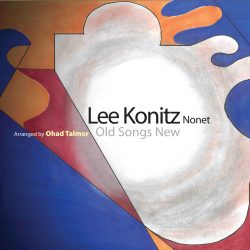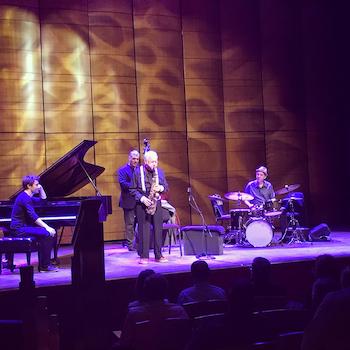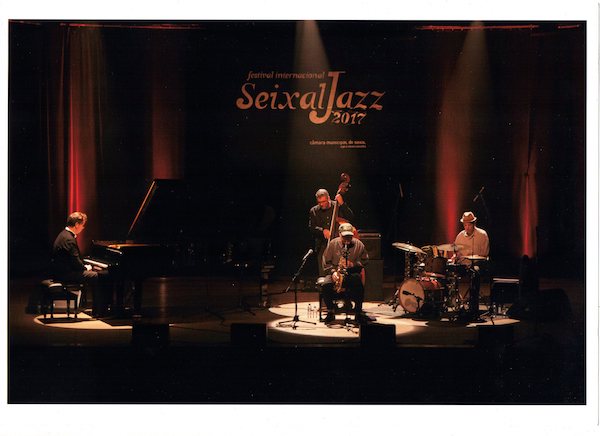Jazz Interview: Drummer George Schuller on Working with Lee Konitz
By Steve Provizer
It amazed me that Lee Konitz in his 90s could still find his way through a maze of changes, chorus after chorus, and at the same time be capable of weaving a beautiful, unscripted melody while producing a sound so wide, one could crawl into it.

Bucharest in 2015: Saxophonist Lee Konitz and drummer George Schuller. Photo: Henning Bolte.
George Schuller performed as percussionist with the recently deceased saxophonist Lee Konitz on and off since 1992. I covered one of their last Boston concerts for Arts Fuse. George has lived in Brooklyn since 1992, but he is well known in Boston. His father, Gunther Schuller, was a composer and musician of considerable note, serving as president of the New England Conservatory of Music from 1967 through 1977. His brother Ed is an accomplished bass player.
George is co-founder of the ensemble Orange Then Blue, and is leader or co-leader of several other groups, including Circle Wide and the George Schuller Trio. He has performed with scores of high-caliber jazz musicians and has recorded as leader and sideman on dozens of records. He played on Lee Konitz’s last recording session, released as Old Songs New. George has received a number of awards for his compositions and was co-producer of the documentary film Music Inn. I asked him about his relationship with Konitz — what it was like to play with such a celebrated saxophone master.
Arts Fuse: I’m sure that long before you met Lee you’d heard his music. What did you think of it?
George Schuller: I believe it was during my days as a volunteer jazz DJ that I began to connect with the recordings of Lee Konitz. I was hosting a regular jazz program at WTBS (later to become WMBR), MIT’s college radio station. I started in 1976 when I was in high school and continued while attending the New England Conservatory of Music. I had access not only to the station’s eclectic library, but to my own collection and to that of my father [Gunther Schuller]. I was fast learning about the breadth of Lee’s recorded legacy: Miles Davis Nonet, Lennie Tristano Quintet, Motion (with Sonny Dallas and Elvin Jones), Konitz Duets, etc., right up to what was, at that time, his latest releases — the nonets of the ’70s. All of those recordings made a huge impact on me. Nor was it lost on me that my father had a connection musically with Lee; he participated in the last Birth of the Cool session (in 1950) which produced those iconic 78 sides “Deception,” “Rocker,” “Moon Dreams,” and “Darn That Dream.”
AF: You told me that Lee’s nonet was an influence on you.
 Schuller: There was something about those ’70s nonet tracks that really caught my ear — small enough for an intimate sound, yet large enough for a variety of colors and textures. The blend of soprano sax, piccolo trumpet, bass trombone, electric piano all came into play. And, most of all, the album didn’t sound like something from a typical big band. It was more about line-writing interspersed with hip orchestrated ensemble sections, often constructed around legendary solos, from Satchmo to Lester to Coltrane. And so I was hooked. I heard the nonet live at the old Jazzmania Club in lower Manhattan where Konitz and company held residency on Sunday nights. My brother, Ed Schuller, had been regularly playing bass in the nonet at that time. The night I heard them, Chick Corea happened to be sitting in.
Schuller: There was something about those ’70s nonet tracks that really caught my ear — small enough for an intimate sound, yet large enough for a variety of colors and textures. The blend of soprano sax, piccolo trumpet, bass trombone, electric piano all came into play. And, most of all, the album didn’t sound like something from a typical big band. It was more about line-writing interspersed with hip orchestrated ensemble sections, often constructed around legendary solos, from Satchmo to Lester to Coltrane. And so I was hooked. I heard the nonet live at the old Jazzmania Club in lower Manhattan where Konitz and company held residency on Sunday nights. My brother, Ed Schuller, had been regularly playing bass in the nonet at that time. The night I heard them, Chick Corea happened to be sitting in.
Meanwhile, I had been taking some classes in arranging at NEC and was looking for opportunities to write for large ensembles. I tried out a few things at school and decided to assemble a nonet-sized band — with similar instrumentation to the Konitz group — to play at my recital. The idea was to unearth a few of my father’s old jazz charts and to perform “Boplicity” and “Moon Dreams” from the original Birth of the Cool charts — parts that still had “Miles,” “Gerry,” and “Lee” written in the top corner! My other idea was to see if I could perform a blues by Chick Corea called “Matrix” arranged for the Konitz Nonet from their first recording on Roulette (1977). I called Lee in NYC to see if I could borrow the chart and he told me to go see his arranger, Sy Johnson, who agreed to allow me to make copies of the parts and perform the arrangement for my recital in 1982.
Sy had orchestrated the piano solo from Corea’s trio recording Now He Sings, Now He Sobs. Sy created a section that mimics exactly what Corea played, note for note. With piccolo trumpet and soprano sax leading the way, that arrangement and that performance sparked the idea for a bunch of us students to form a similar-sized ensemble. By 1984, seven of us who had graduated from NEC formed an 11-piece band called Orange Then Blue, adding an extra trumpet and saxophone, but still using the Konitz Nonet’s instrumentation as an initial guiding model.
AF: How did it come about that you began playing with Konitz? And how long did you end up performing with him?
Schuller: I had been hankering to play with Lee and finally got the courage to call him for a few gigs in New England around 1992. He was coming up to Boston that spring to play at Scullers with his NYC quartet, which included pianist Peggy Stern and drummer Jeff Williams. Since he was in town for those weekend appearances at Scullers, I decided to book my own trio gigs with him at Café No in Portland, ME, and down in Providence, RI, at the alternative rock club called AS-220.
Both gigs were an exhilarating learning experience for me, especially since Lee thoroughly explored that wide open, piano-less group construct; something Rollins, Mulligan, Ornette, and others were famous for. Lee was also famous for choosing familiar standards and well-worn ballads, but most of the time he would begin soloing unaccompanied without announcing what it was or what key he was in. It was usually up to us to join in somewhere down the line and pick it up at the bridge or by the second chorus — as long as we knew what he was playing. Generally, we figured it out within a few bars, but if there was some slight hesitancy about our entrance, he would stop his introduction midway and announce to the audience, as if to reinforce our timidity, “Quiet band…”
I remember the drive back to Boston with Lee after the Café No gig. At some point, while listening to a local jazz station, Lee fell asleep. Minutes later, as if on cue, the next radio set started with Tristano Quintet sides from the late ’40s with Warne Marsh. Looking at Lee, I suddenly had a surreal out-of-body thought — here I am driving with one of the legends of improvisation and they’re playing “Progression” and “Intuition,” those early free Tristano experiments that predate Cecil, Ornette, and the rest by almost 10 years. No, I did not wake him up — thought better of it, of course.

2017 at The Kennedy Center: Dan Tepfer, Jeremy Stratton, Lee Konitz and George Schuller. Photo:Brad Linde.
Fast forward to 2004, I had already moved to Brooklyn. Andreas Scherrer, who had been helping me book my own groups, had also worked with Lee on various eclectic touring projects. With offers for Lee to bring a group to Europe, Andreas hatched the idea that maybe Lee should be playing with a stable rhythm section. In those years, and pretty much throughout his career, Lee was not one to stick with the same side-mates for more than one recording and/or one tour. His attitude toward rhythm sections was like his touring: all over the map!
Andreas suggested that he hire my brother, Ed Schuller, on bass and myself to form a simple touring trio and Lee agreed. It was kind of like Konitz meets The Schulldogs (a slightly more adventurous free-floating group I had formed in the ’90s with my brother). Some of the early gigs ended up a bit more edgy than perhaps Lee would’ve liked — “All the Things You Are,” “Cherokee,” and “Body & Soul” untethered and shapeshifted. Lee kept saying to us that he wanted to play free and the two of us took that to mean—licking our chops—“like, literally…free…? Ok, you got it.”
Occasionally, musical chaos ensued — loose time, rubbery melodies, and stretched harmonies — as we rambled far afield on the standards and ballads Lee loved to play. I thought a lot of it worked in a twisted Ornette-ish way, but I’m not sure the audience was buying it and neither was Lee. It suddenly dawned on us that maybe he was looking to stretch and play free over and around a steady pulse. We should keep the harmony and structure true. So by the third or fourth gig, we all came to a mutually agreeable compromise. Lee was happy and we finished that first tour as a unified and swingin’ trio.
During the late 2000s and for the next decade, Lee called me up not only for some choice local gigs, but also for several overseas tours. Dan Tepfer had become one of Lee’s favorite pianists and a key member of the group, while bassist Jeremy Stratton and I had musically bonded on a regular basis at the Grassroots Tavern, a haunt in the East Village. We formed what was more or less Lee’s working quartet during those last 10 years of public performance. When Dan was not available, Lee invited German-born pianist Florian Weber to join the quartet — especially when we toured in Europe. However, we were by no means his only working quartet. Lee continued to be in high demand: competing agents and musicians with active label representation had other ideas about rhythm section possibilities that didn’t necessarily include us.
Still, there were several key opportunities for us to play in NYC and stateside throughout the 2010s including a thrilling weekend at the Village Vanguard (a significant high point in my life), two appearances at New York’s annual Charlie Parker Jazz Festival, and festivals in Newport, New Orleans, and at the Kennedy Center in Washington, DC. We also played several times in the Boston/Cambridge area at the Regattabar and significantly, at Scullers in December 2018, which turned out to be our last official quartet concert; this time with pianist Bruce Barth and bassist Joe Fitzgerald.
In addition, overseas tours afforded us high-profile gigs at jazz festivals and clubs all over Europe, Israel, and Asia. One memorable performance was at the Blue Note in Beijing. The club was packed and the audience reacted enthusiastically all weekend. After each gig, long lines formed for autograph seekers. Lee generally grumbled about post-concert autograph signing; always hoping to sneak out and head straight for the hotel. But this time the lines were too long for him to dismiss. Jeremy and I stood there in awe watching these avid fans wait patiently just to get a Konitz scrawl on a piece of paper. There were several who had brought their old Konitz recordings for Lee to sign. One fan with a handful of old 10-inch records under his arm crept up quietly to the signing table and without warning, wept openly in front of Lee. This poor guy had probably waited a generation to see his hero in the flesh, clutching ancient, out-of-print Konitz LPs. It was as if Pope Lee was about to perform a baptism. This, of all places, in Beijing! I was touched as I watched this unfold. It showed Lee’s global reach, especially in that particular corner of the world.
AF: He was pretty elderly at the point when you were playing with him and I imagine you had to make some adjustments for his energy level, etc. What can you tell us about that?
Schuller: We were all cognizant of the fact that Lee in his 80s and early 90s wasn’t going to be the Lee of earlier times. So it was up to us to gauge every situation as it presented itself, to tread carefully and fine tune right on the spot. The object was to make him feel as if he was playing from a soft, comfortable recliner in his living room, although occasionally he may have gotten too comfortable.
As for the gigs, Lee was the ultimate compulsive improvisor. We followed his lead wherever that took us — that was both the challenge and the fun part. He seemed to be up for most of our prodding and toying, yet he could also return the favor on a dime. Lee was acutely aware of his sidemen and of his audience. He was always in the moment and nothing more. That’s what he lived for.

Portugal, Festival International Seixal Jazz 2017: Florian Weber, Jeremy Stratton, Lee Konitz and George Schuller. Photo: João de Barros.
His “line” tunes, the ones based on familiar chord changes like “Kary’s Trance,” “Subconscious-Lee,” “Thingin,” and Tristano’s “317 East 32nd Street,” all had to be slowed down to medium tempo explorations. Ballads like “Round Midnight” and “Darn That Dream” (a possible inspired holdover from the Birth of the Cool session?) had now become signature portraits of an aging icon. And Lee was singing more and playing less. Some of that, I believe, was to pace himself over a long set or two but, deep down, he really enjoyed the “wordless singing” (to quote journalist Dan Morgenstern). His singing was merely an extension of his saxophone playing — perhaps a bit pitchy in places, but who cared. It was honest and true, and at times almost heartbreaking.
Sure, he had physical and mental lapses on stage and off; who wouldn’t at that age? But the music was always his clarion call. It amazed me that Lee in his 90s could still find his way through a maze of changes, chorus after chorus, and at the same time be capable of weaving a beautiful, unscripted melody while producing a sound so wide, one could crawl into it. That’s what we all lived for.
AF: In terms of jazz history, how do you think Lee will be remembered?
Schuller: Lee wasn’t one to open up about his accomplishments or what he had yet to achieve, but one of his goals in life was to keep simplifying his approach to improvising. Clear notes and pure sound was his mantra — a kind of stripped-down, daily rationing of everything he had heard, studied, absorbed, and played. Lee had become the perfect jazz Buddhist in a white leisure suit, albeit excused for the occasional kvetch.
In 1977, at the less-than-ripe old age of 50, he said in an interview, “I know in my heart that I’ve paid my dues and I guess I can function as a senior citizen of jazz if I stay in good health…. I feel that I’d like to keep going on. And I think as long as I have my marbles about me, I can continue to be as creative as I can be. And that’s fine by me. I’m delighted to be able to do that for a lifetime.” He also quipped, “And I’m working on a double lip embouchure, so when my teeth are gone, I can still play.” Lee’s self-deprecating sense of humor was ceaseless.
Now that Lee has joined Miles, Gerry, JJ, Max, John, Klook, Gil, Gunther, and the rest of the Birth of the Cool participants, they can all finally climb on that bus and start the tour they never had.
Steve Provizer writes on a range of subject, most often the arts. He is a musician and blogs about jazz here.

A great interview, George! Many thanks
It is not often that you get “Criticism” on a very high level from the inside perspective of
a great musician. This kind of writing, even as a recorded interview, almost makes you hear the music. And then, since we are talking about George Schuller, you get the vast enveloping action of his career as a drummer over many years. Always close to, or inside of his subject, you come away feeling like you got to know Lee Konitz along with his music.
Gray Smith
1960 School of Jazz